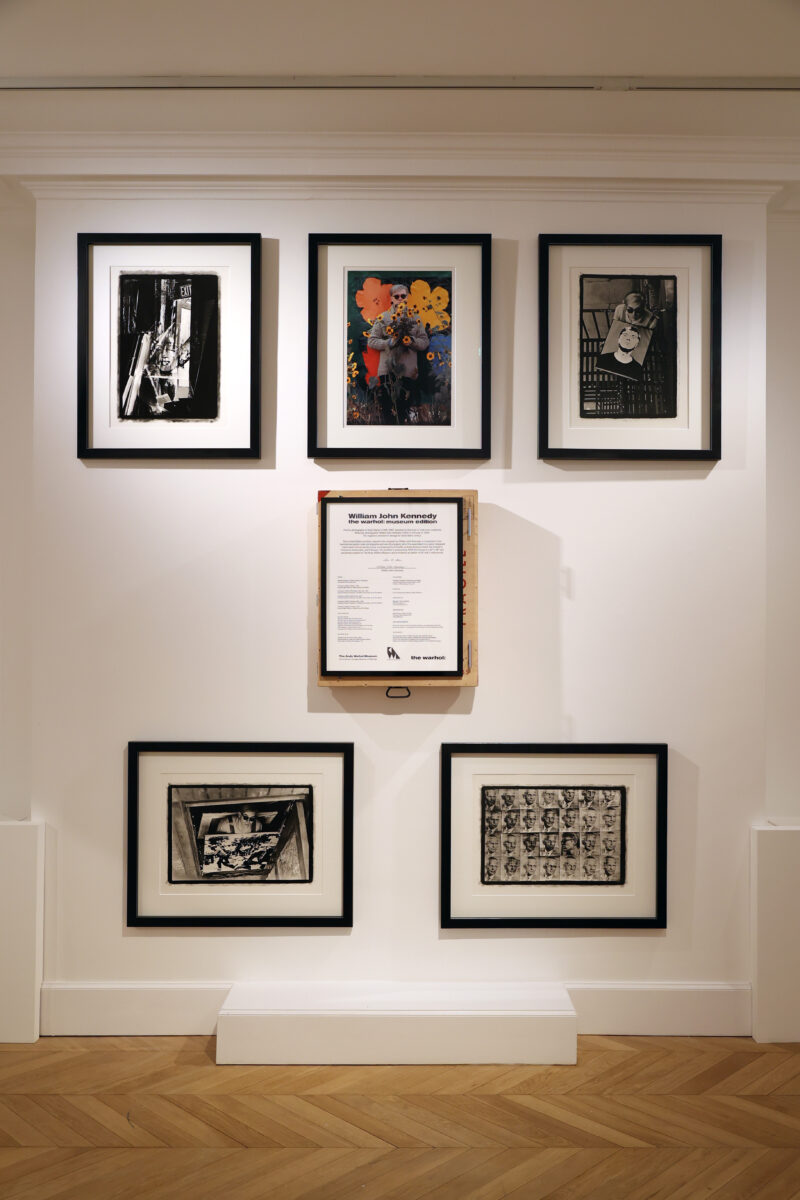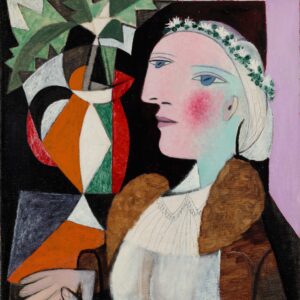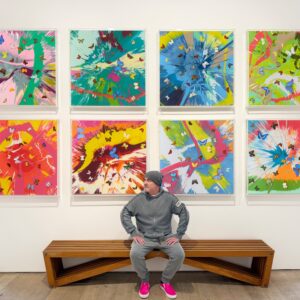
Joseph Bannan, Partner and Curator of Woodbury House in London, talks to Lee Sharrock about a new solo exhibition showcasing a rediscovered photographic archive of Andy Warhol photos by the late William John Kennedy.

‘The Lost Archive of Andy Warhol’ features 30 signed photographs taken of Warhol in the early 1960s by William John Kennedy, plus a limited edition portfolio, which was exclusively created for The Andy Warhol Museum. The Limited-Edition portfolio, signed in the colophon by William John Kennedy, consists of four hand-printed gelatin silver photographs and one chromogenic print, in a custom-designed hand-made archival aluminium box, accompanied by 6 smaller archival aluminium boxes including a Foreword, Introduction, and five Essays.

The collection of photographs featured in ‘The Lost Archive of Andy Warhol’ includes photographs of Warhol at The Factory, including an iconic image of Warhol peering through an acetate of his famous ‘Marilyn’ screenprint, and Warhol capture with Robert Indiana at Indiana’s Museum of Modern Art exhibition in 1963. The image of Warhol with the Marilyn acetate is historically significant, as it offers a glimpse into the earliest iteration of a work that would later fetch a staggering $195 million at auction, becoming the seventh most expensive artwork sold ever.

Lee Sharrock: How did Woodbury House get involved with the estate of John William Kennedy, and what is the relationship with the Warhol Museum and the images you are exhibiting?
Joseph Bannan: I was first introduced to Neil Bookatz, and subsequently, Adrian Green, who represent Kiwi Arts Group. Kiwi Arts Group, while not the estate of William John Kennedy, acts as the publisher for his images and holds the intellectual property rights for his work. When Kennedy rediscovered the negatives of his images, including those of Warhol and Indiana, he shared them with Adrian Green, leading to a partnership with Kiwi Arts Group.
Since then, they have collaborated with Kennedy to reproduce and exhibit the images, showcasing them at prestigious events like Art Basel and partnering with The Andy Warhol Museum. This collaboration resulted in the publication of a book and the release of a documentary titled ‘Full Circle – Before They Were Famous,’ which premiered at the Tribeca Film Festival. Neil Bookatz has been a staunch supporter of the project from the beginning, introducing the imagery to myself and the Woodbury House team. We have been captivated by the historical importance and the personality that these images reveal of Andy Warhol, and we are eagerly anticipating unveiling them at the exhibition.
Regarding our relationship with The Andy Warhol Museum for this project, it is indirect, as we are exhibiting images from the collection of Kiwi Arts Group. However, Kiwi Arts Group and The Andy Warhol Museum have had a direct partnership in the past. The museum released the ONLY limited edition they have ever done in their history, featuring five images by William John Kennedy. This release coincided with Art Basel and was launched at the Versace Mansion. Through this project, I was introduced to Patrick Moore, the director of the museum, who has been incredibly supportive of our exhibition. He has generously provided a foreword for the exhibition catalogue and participated in an interview discussing William John Kennedy’s work and its significance within the broader context of Andy Warhol’s narrative, which we will be releasing very soon!
LS: ‘The Lost Archive of Andy Warhol’ is an exhibition at Woodbury House of 30 signed photographs by William John Kennedy taken in the early 1960s, which capture the essence of Warhol. Can you give a bit of insight into the photographs and why these 30 were chosen for the exhibition and accompanying museum edition portfolio, which has been created exclusively for the Andy Warhol Museum?
JB: When curating the exhibition, we carefully examined the remarkable portfolio of images captured by William John Kennedy of Andy Warhol. We aimed to create a curated mix that effectively sets the tone for the exhibition’s narrative.
Our primary objectives were to:
Highlight the pivotal moment of William John Kennedy and Andy Warhol’s initial meeting, a critical point in their relationship. This introduction occurred at a show opening at The Museum of Modern Art, facilitated by Robert Indiana. Visitors to the exhibition will be transported back to this momentous occasion, providing essential context to the beginning of their journey. Warhol’s subsequent invitation to Kennedy to visit the Factory for a photo shoot, initially met with disbelief, marked the start of their collaboration.
Showcase Kennedy’s multifaceted role beyond being merely a photographer in the Factory. We wanted to emphasize his direct involvement in directing Warhol to capture the perfect shot, often featuring Warhol alongside his art. One notable example is the iconic Flowers series. Kennedy’s initiative and creative direction shine through in these images, underscoring his contributions beyond capturing moments but also shaping them artistically.
Reveal a softer, more personable side of Andy Warhol’s personality, often overshadowed by his serious persona. Through Kennedy’s lens, Warhol comes across as personable, charming, and playful, reflecting a young man enjoying the process of creating art without fully knowing the trajectory of his future fame.
Highlight the significant collaboration between William John Kennedy and The Andy Warhol Museum, underscoring Kennedy’s credibility and status within the art world. The museum’s decision to release the only official limited edition in its history with Kennedy amplifies his reputation and sets him apart from other photographers. The inclusion of this collaboration adds prestige and exclusivity to the exhibition, elevating the importance of Kennedy’s work. With only one limited edition available, it is sure to become a desirable acquisition for collectors, sparking conversations and enhancing the exhibition’s appeal.
Through these objectives, we aim to provide visitors with a comprehensive understanding of the historical significance and artistic merit of William John Kennedy’s images of Andy Warhol, ensuring an enriching and memorable exhibition experience.

LS: How many Limited Edition portfolios of the photographs will be available?
JB: Each image showcased in the exhibition is available for acquisition but is limited to only one print per image. This scarcity adds a special allure to the collection, making it a rare opportunity for both collectors and art enthusiasts. With the high demand surrounding the exhibition and the numerous requests for private viewings and attendance at the opening, we anticipate strong sales for this exceptional collection of works.
LS: William John Kennedy’s portrait of Warhol looking out through the Marilyn acetate is displayed in the entrance of The Andy Warhol Museum. Are you exhibiting this image at Woodbury House?
JB: Absolutely. As you enter the gallery, we’ve aimed to set a precedent with a striking display featuring a huge vinyl of the same iconic image showcased at the Museum’s entrance. This larger-than-life display immediately sets the tone for the exhibition. Additionally, throughout the gallery, you’ll encounter various images of Andy with the Marilyn acetate, each presented in different variations and sizes available for acquisition.
All the images chosen that feature Andy with the ‘Marilyn’ acetate, which is perhaps my favourite of the collection, highlight Andy’s character but also spark intriguing conversations about fate and luck. This image holds immense significance as it marks the very first moment William John Kennedy captured Andy on film. It’s fascinating to think about the circumstances surrounding this moment—Kennedy being asked to take a photo with an acetate, randomly choosing one from a pile, and it happens to be the iconic Marilyn image. Moreover, as Kennedy lifts the acetate, the light piercing through the factory windows illuminates Andy in a truly serendipitous manner. What are the chances? Is this fate? Is this luck?
Considering the monumental sale of ‘Shot Sage Blue Marilyn, 1964’, which sold at Christie’s for $195,000,000.00 in 2022, the journey and impact of this image become even more profound. Perhaps William and Andy had an inkling of its significance, or maybe it was purely chance. Regardless, it serves as a testament to the power of this moment captured—a moment that takes us back to the very start of a global artwork’s journey. From then to now, this creation by Andy has become globally recognized and cherished by many, leaving an indelible mark on the world of art. The image captured by William allows us to transport back in time to see the very start of this incredible journey. To be able to exhibit that at Woodbury House and allow our collectors to go on that journey is a delight for all of us.
LS: William John Kennedy’s photographs of Warhol were forgotten for years, and only rediscovered via a misattributed photograph in a book on Andy Warhol. Can you explain who discovered the image and attributed it to Kennedy, and how events unfolded after that moment, leading to his work being featured in museum collections around the world including the Warhol museum?
JB: Upon the release of the book, a friend showed it to William John Kennedy. Upon reading it, he noticed an image misattributed to a different photographer. Kennedy was adamant that it was his image and set out to regroup all of his archives to locate it. These archives had been sitting in a box in the loft for almost 50 years, nearly discarded at one point. Kennedy remembered exhibiting the image only once at an exhibition at the Sydney Janis Gallery in 1967 in New York City, titled ‘Homage to Marilyn Monroe,’ which featured works by various renowned artists including Andy Warhol, Robert Indiana, Richard Avedon, Henri Cartier-Bresson, John Chamberlain, Salvador Dali, Willem de Kooning, Robert Indiana, Marisol, Claes Oldenburg, Robert Rauschenberg, James Rosenquist, and Tom Wesselmann, alongside William John Kennnedys image.
Upon discovering the misattributed image in the book, a friend brought it to William John Kennedy’s attention. Upon reviewing the book, Kennedy recognised the image as his own and was determined to rectify the error. He embarked on a mission to locate all of his archives, which had been stored in a box in the loft for nearly 50 years and were on the verge of being discarded. Kennedy distinctly recalled exhibiting the image only once at an exhibition at the Sydney Janis Gallery in 1967 in New York City. This exhibition, titled ‘Homage to Marilyn Monroe,’ showcased works by various renowned artists, including Andy Warhol, Robert Indiana, Richard Avedon, Henri Cartier-Bresson, John Chamberlain, Salvador Dali, Willem de Kooning, Robert Indiana, Marisol, Claes Oldenburg, Robert Rauschenberg, James Rosenquist, and Tom Wesselmann, alongside Kennedy’s own image.
The only possible explanation for someone else laying claim to this work was that someone must have visited that exhibition and taken a photograph of the image. Since Kennedy had effectively disappeared from the scene and had not done anything with his images of Warhol, including this particular ‘Marilyn’ image, someone else saw the opportunity to pass it off as their own. This incident became their downfall and a comeback for William John Kennedy. With newfound attention and a mission to prove himself, he diligently dug through his archives, found the infamous box, and meticulously catalogued the negatives. This led to the reproduction and publication of his images.
From that point on, Kennedy’s journey gained momentum. With the invaluable support of Kiwi Arts Group, he achieved significant accomplishments such as collaborating with museums, releasing a documentary and a book, and participating in notable exhibitions and press coverage. Despite these achievements, Kennedy remains relatively unknown on a global scale. Many people, including myself until recently, are unaware of his work. However, I strongly believe that his name rightfully deserves recognition for the beautiful images he captured, which are undoubtedly an important part of the research and journey of Andy Warhol’s work just before his emergence on the global stage.
I hope that this exhibition provides Kennedy with the exposure he deserves, enhances the credibility of his work, and establishes the name William John Kennedy in its own right moving forward. It’s a privilege to be a part of showcasing his remarkable talent and contribution to the art world.
LS: The Woodbury House exhibition features an iconic image of the moment Robert Indiana introduced Warhol to Kennedy, at a 1963 Museum of Modern Art exhibition of Indiana’s art. Is this a rare photograph of Indiana and Warhol together?
JB: Absolutely, the image captured by William John Kennedy is indeed rare and holds immense significance. The portrayal of Andy Warhol without his iconic glasses adds a unique aspect to the photograph, showcasing a side of him that is not commonly seen. The moment shared between Warhol and Robert Indiana at the Museum of Modern Art, with Indiana introducing Warhol to Kennedy, adds depth and context to the image, highlighting the interconnectedness of these influential figures in the art world. Kennedy’s skill as a photographer is evident in his ability to capture such intimate moments, providing viewers with insights into the lives of cultural icons before they reached global fame. It’s a testament to Kennedy’s talent and the enduring power of photography to capture history as it unfolds.
LS: Any plans to tour the exhibition to other cities after the Woodbury House exhibition?
JB: Absolutely, we are thrilled about this project, especially given that it marks the inaugural collaboration between Woodbury House and Kiwi Arts Group. The current exhibition serves as a significant milestone, laying the foundation for what we anticipate will be a fruitful partnership. With Kiwi Arts Group’s extensive catalogue, which includes not only the historically important Warhol images but also those of Indiana and other artists, the potential for future endeavours is immense. While we are fully focused on delivering an exceptional inaugural exhibition, I’m confident that we’ll soon be sharing updates on our future plans. The possibilities for further exploration and collaboration between Woodbury House and Kiwi Arts Group are vast, and I’m excited to see where this partnership takes us next.

‘The Lost Archive of Andy Warhol’ February 29th to March 21st, 2024, Woodbury House
To make an appointment to view the exhibition please contact gallery@woodburyhouseart.com or call + 44 (0) 203 750 2222.







